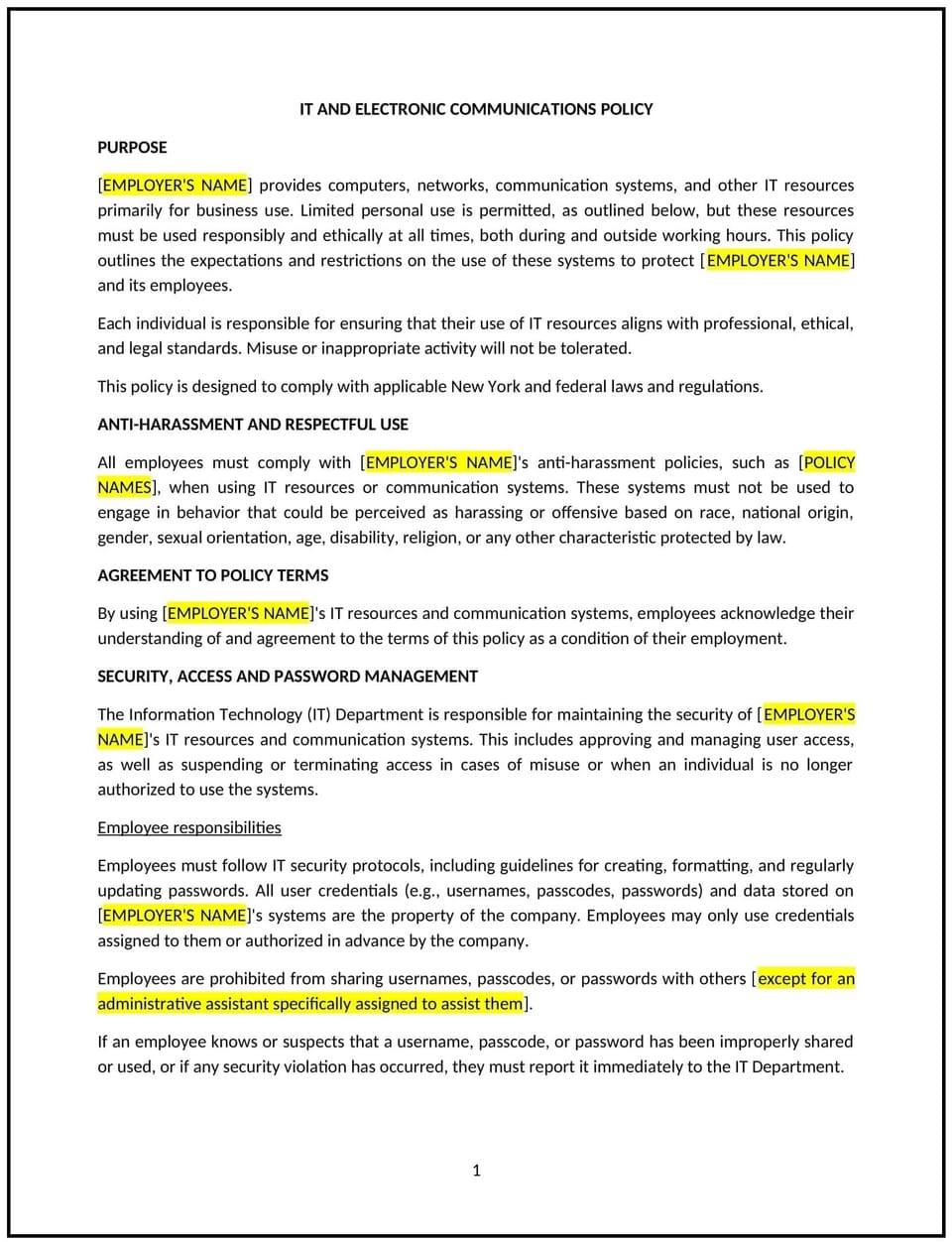IT and electronics communication policy (New York): Free template

IT and electronic communication policy (New York)
This IT and electronic communication policy is designed to help New York businesses establish clear guidelines for the responsible and secure use of company IT resources and electronic communication tools. Whether businesses are managing device usage, safeguarding data, or promoting appropriate communication practices, this template outlines key considerations to maintain a secure and professional digital environment.
By adopting this template, businesses can mitigate security risks, enhance productivity, and foster responsible use of technology.
How to use this IT and electronic communication policy (New York)
- Define acceptable use: Clearly specify how company IT resources, such as computers, email, and internet access, may be used for work-related activities.
- Address personal use: Outline rules for limited personal use of IT resources, ensuring it does not interfere with work responsibilities or compromise security.
- Highlight security requirements: Include guidelines for password management, data encryption, and secure access to company systems.
- Set communication standards: Provide expectations for appropriate and professional use of email, messaging apps, and other electronic communication tools.
- Include monitoring and compliance: Inform employees about company rights to monitor IT resource usage to maintain compliance with policy standards.
Benefits of using an IT and electronic communication policy (New York)
This policy offers several benefits for New York businesses:
- Protects company data: Clear rules for IT resource use reduce the risk of data breaches and unauthorized access.
- Promotes professionalism: Setting communication standards ensures that interactions via electronic tools reflect the company’s values and professionalism.
- Enhances productivity: Guidelines for appropriate use help minimize distractions and focus IT resources on business operations.
- Reduces security risks: Policies on password management and secure access protect against cybersecurity threats.
- Supports compliance: Aligning with data protection regulations and best practices ensures businesses meet legal and ethical responsibilities.
Tips for using this IT and electronic communication policy (New York)
- Train employees: Offer regular training sessions on cybersecurity best practices, such as recognizing phishing attempts and creating strong passwords.
- Regularly update systems: Ensure IT infrastructure is maintained with regular updates and patches to minimize vulnerabilities.
- Encourage reporting: Create a clear process for employees to report IT-related issues, such as suspected phishing emails or device malfunctions.
- Provide device management tools: Use monitoring tools to manage company-owned devices and enforce security measures, such as remote data wiping for lost or stolen devices.
- Review the policy regularly: Update the policy to reflect changes in IT systems, business operations, or New York regulations.
Q: Why is an IT and electronic communication policy important for businesses?
A: This policy helps businesses protect sensitive data, maintain productivity, and comply with data protection regulations by providing structured guidelines for IT resource use.
Q: What security measures should businesses implement under this policy?
A: Businesses should enforce password management protocols, enable multi-factor authentication, encrypt sensitive data, and provide regular software updates.
Q: How can businesses address non-compliance with this policy?
A: Businesses can implement monitoring systems to detect non-compliance and enforce corrective actions, such as additional training or disciplinary measures.
Q: Are there legal implications for businesses not having such a policy?
A: While not always legally required, having a clear policy reduces risks associated with data breaches, regulatory non-compliance, and unauthorized IT use.
Q: How often should the policy be updated?
A: The policy should be reviewed annually or when significant changes occur in IT systems, security risks, or data protection regulations.
This article contains general legal information and does not contain legal advice. Cobrief is not a law firm or a substitute for an attorney or law firm. The law is complex and changes often. For legal advice, please ask a lawyer.


